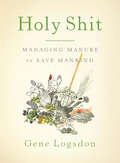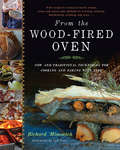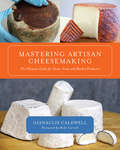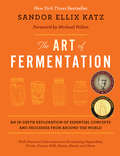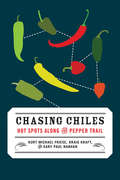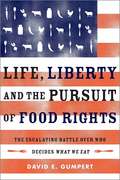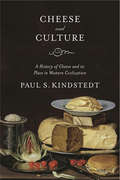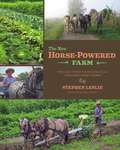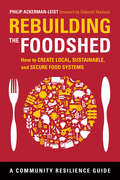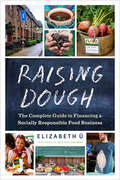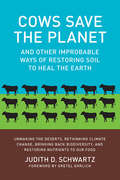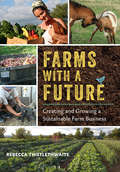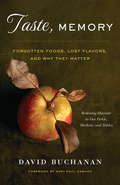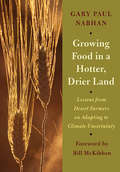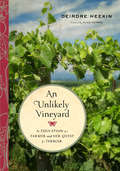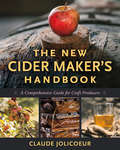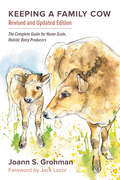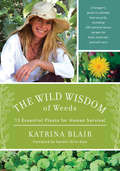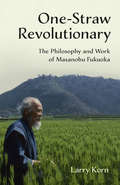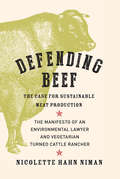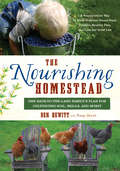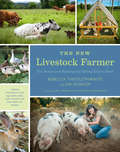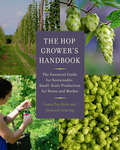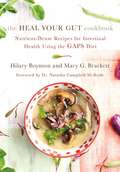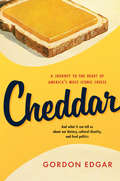- Table View
- List View
Holy Sh*t: Managing Manure to Save Mankind
by Gene Logsdon Brooke BudnerIn his insightful new book, Holy Sh*t: Managing Manure to Save Mankind, contrary farmer Gene Logsdon provides the inside story of manure-our greatest, yet most misunderstood, natural resource. He begins by lamenting a modern society that not only throws away both animal and human manure-worth billions of dollars in fertilizer value-but that spends a staggering amount of money to do so. This wastefulness makes even less sense as the supply of mined or chemically synthesized fertilizers dwindles and their cost skyrockets. In fact, he argues, if we do not learn how to turn our manures into fertilizer to keep food production in line with increasing population, our civilization, like so many that went before it, will inevitably decline. With his trademark humor, his years of experience writing about both farming and waste management, and his uncanny eye for the small but important details, Logsdon artfully describes how to manage farm manure, pet manure and human manure to make fertilizer and humus. He covers the field, so to speak, discussing topics like: How to select the right pitchfork for the job and use it correctly How to operate a small manure spreader How to build a barn manure pack with farm animal manure How to compost cat and dog waste How to recycle toilet water for irrigation purposes, and How to get rid ourselves of our irrational paranoia about feces and urine. Gene Logsdon does not mince words. This fresh, fascinating and entertaining look at an earthy, but absolutely crucial subject, is a small gem and is destined to become a classic of our agricultural literature.
From the Wood-Fired Oven: New and Traditional Techniques for Cooking and Baking with Fire
by Richard Miscovich Daniel WingIn the past twenty years, interest in wood-fired ovens has increased dramatically in the United States and abroad, but most books focus on how to bake bread or pizza in an oven. From the Wood-Fired Oven offers many more techniques for home and artisan bakers—from baking bread and making pizza to recipes on how to get as much use as possible out of a single oven firing, from the first live-fire roasting to drying wood for the next fire. From the Wood-Fired Oven offers a new take on traditional techniques for professional bakers, but is simple enough to inspire any nonprofessional baking enthusiast. Leading baker and instructor Richard Miscovich wants people to use their ovens to fulfill the goal of maximum heat utilization. Readers will find methods and techniques for cooking and baking in a wood-fired oven in the order of the appropriate temperature window. What comes first—pizza, or pastry? Roasted vegetables or a braised pork loin? Clarified butter or beef jerky? In addition to an extensive section of delicious formulas for many types of bread, readers will find chapters on: • Making pizza and other live-fire flatbreads; • Roasting fish and meats; • Grilling, steaming, braising, and frying; • Baking pastry and other recipes beyond breads; • Rendering animal fats and clarifying butter; • Food dehydration and infusing oils; • And myriad other ways to use the oven's residual heat. Appendices include oven-design recommendations, a sample oven temperature log, Richard's baker's percentages, proper care of a sourdough starter, and more. . . . From the Wood Fired Oven is more than a cookbook; it reminds the reader of how a wood-fired oven (and fire, by extension) draws people together and bestows a sense of comfort and fellowship, very real human needs, especially in uncertain times. Indeed, cooking and baking from a wood-fired oven is a basic part of a resilient lifestyle, and a perfect example of valuable traditional skills being put to use in modern times.
Mastering Artisan Cheesemaking: The Ultimate Guide for Home-Scale and Market Producers
by Gianaclis Caldwell Ricki CarrollThe key to becoming a successful artisan cheesemaker is to develop the intuition essential for problem solving and developing unique styles of cheeses. There are an increasing number of books on the market about making cheese, but none approaches the intricacies of cheesemaking science alongside considerations for preparing each type of cheese variety in as much detail as Mastering Artisan Cheesemaking. Indeed, this book fills a big hole in the market. Beginner guides leave you wanting more content and explanation of process, while recipe-based cookbooks often fail to dig deeper into the science, and therefore don’t allow for a truly intuitive cheesemaker to develop. Acclaimed cheesemaker Gianaclis Caldwell has written the book she wishes existed when she was starting out. Every serious home-scale artisan cheesemaker—even those just beginning to experiment—will want this book as their bible to take them from their first quick mozzarella to a French mimolette, and ultimately to designing their own unique cheeses. This comprehensive and user-friendly guide thoroughly explains the art and science that allow milk to be transformed into epicurean masterpieces. Caldwell offers a deep look at the history, science, culture, and art of making artisan cheese on a small scale, and includes detailed information on equipment and setting up a home-scale operation. A large part of the book includes extensive process-based recipes dictating not only the hard numbers, but also the concepts behind each style of cheese and everything you want to know about affinage (aging) and using oils, brushes, waxes, infusions, and other creative aging and flavoring techniques. Also included are beautiful photographs, profiles of other cheesemakers, and in-depth appendices for quick reference in the preparation and aging room. Mastering Artisan Cheesemaking will also prove an invaluable resource for those with, or thinking of starting, a small-scale creamery. Let Gianaclis Caldwell be your mentor, guide, and cheering section as you follow the pathway to a mastery of cheesemaking. For the avid home hobbyist to the serious commercial artisan, Mastering Artisan Cheesemaking is an irreplaceable resource.
The Art of Fermentation: An In-Depth Exploration of Essential Concepts and Processes from around the World
by Sandor Ellix Katz Michael PollanWinner of the 2013 James Beard Foundation Book Award for Reference and Scholarship, and a New York Times bestseller, The Art of Fermentation is the most comprehensive guide to do-it-yourself home fermentation ever published. Sandor Katz presents the concepts and processes behind fermentation in ways that are simple enough to guide a reader through their first experience making sauerkraut or yogurt, and in-depth enough to provide greater understanding and insight for experienced practitioners. While Katz expertly contextualizes fermentation in terms of biological and cultural evolution, health and nutrition, and even economics, this is primarily a compendium of practical information—how the processes work; parameters for safety; techniques for effective preservation; troubleshooting; and more. With two-color illustrations and extended resources, this book provides essential wisdom for cooks, homesteaders, farmers, gleaners, foragers, and food lovers of any kind who want to develop a deeper understanding and appreciation for arguably the oldest form of food preservation, and part of the roots of culture itself. Readers will find detailed information on fermenting vegetables; sugars into alcohol (meads, wines, and ciders); sour tonic beverages; milk; grains and starchy tubers; beers (and other grain-based alcoholic beverages); beans; seeds; nuts; fish; meat; and eggs, as well as growing mold cultures, using fermentation in agriculture, art, and energy production, and considerations for commercial enterprises. Sandor Katz has introduced what will undoubtedly remain a classic in food literature, and is the first—and only—of its kind.
Chasing Chiles: Hot Spots along the Pepper Trail
by Gary Paul Nabhan Kraig Kraft Kurt Michael FrieseChasing Chiles looks at both the future of place-based foods and the effects of climate change on agriculture through the lens of the chile pepper-from the farmers who cultivate this iconic crop to the cuisines and cultural traditions in which peppers play a huge role. Why chile peppers? Both a spice and a vegetable, chile peppers have captivated imaginations and taste buds for thousands of years. Native to Mesoamerica and the New World, chiles are currently grown on every continent, since their relatively recent introduction to Europe (in the early 1500s via Christopher Columbus). Chiles are delicious, dynamic, and very diverse-they have been rapidly adopted, adapted, and assimilated into numerous world cuisines, and while malleable to a degree, certain heirloom varieties are deeply tied to place and culture-but now accelerating climate change may be scrambling their terroir. Over a year-long journey, three pepper-loving gastronauts-an agroecologist, a chef, and an ethnobotanist-set out to find the real stories of America's rarest heirloom chile varieties, and learn about the changing climate from farmers and other people who live by the pepper, and who, lately, have been adapting to shifting growing conditions and weather patterns. They put a face on an issue that has been made far too abstract for our own good. Chasing Chiles is not your archetypal book about climate change, with facts and computer models delivered by a distant narrator. On the contrary, these three dedicated chileheads look and listen, sit down to eat, and get stories and recipes from on the ground-in farmers' fields, local cafes, and the desert-scrub hillsides across North America. From the Sonoran Desert to Santa Fe and St. Augustine (the two oldest cities in the U.S.), from the marshes of Avery Island in Cajun Louisiana to the thin limestone soils of the Yucatan, this book looks at how and why climate change will continue to affect our palates and our producers, and how it already has.
Life, Liberty, and the Pursuit of Food Rights: The Escalating Battle Over Who Decides What We Eat
by David E. GumpertDo Americans have the right to privately obtain the foods of our choice from farmers, neighbors, and local producers, in the same way our grandparents and great grandparents used to do? Yes, say a growing number of people increasingly afraid that the mass-produced food sold at supermarkets is excessively processed, tainted with antibiotic residues and hormones, and lacking in important nutrients. These people, a million or more, are seeking foods outside the regulatory system, like raw milk, custom-slaughtered beef, and pastured eggs from chickens raised without soy, purchased directly from private membership-only food clubs that contract with Amish and other farmers. Public-health and agriculture regulators, however, say no: Americans have no inherent right to eat what they want. In today's ever-more-dangerous food-safety environment, they argue, all food, no matter the source, must be closely regulated, and even barred, if it fails to meet certain standards. These regulators, headed up by the U.S. Food and Drug Administration, with help from state agriculture departments, police, and district-attorney detectives, are mounting intense and sophisticated investigative campaigns against farms and food clubs supplying privately exchanged food-even handcuffing and hauling off to jail, under threat of lengthy prison terms, those deemed in violation of food laws. Life, Liberty, and the Pursuit of Food Rights takes readers on a disturbing cross-country journey from Maine to California through a netherworld of Amish farmers paying big fees to questionable advisers to avoid the quagmire of America's legal system, secret food police lurking in vans at farmers markets, cultish activists preaching the benefits of pathogens, U.S. Justice Department lawyers clashing with local sheriffs, small Maine towns passing ordinances to ban regulation, and suburban moms worried enough about the dangers of supermarket food that they'll risk fines and jail to feed their children unprocessed, and unregulated, foods of their choosing. Out of the intensity of this unprecedented crackdown, and the creative and spirited opposition that is rising to meet it, a new rallying cry for food rights is emerging.
Cheese and Culture: A History of Cheese and its Place in Western Civilization
by Paul KindstedtBehind every traditional type of cheese there is a fascinating story. By examining the role of the cheesemaker throughout world history and by understanding a few basic principles of cheese science and technology, we can see how different cheeses have been shaped by and tailored to their surrounding environment, as well as defined by their social and cultural context. Cheese and Culture endeavors to advance our appreciation of cheese origins by viewing human history through the eyes of a cheese scientist. There is also a larger story to be told, a grand narrative that binds all cheeses together into a single history that started with the discovery of cheese making and that is still unfolding to this day. This book reconstructs that 9000-year story based on the often fragmentary information that we have available. Cheese and Culture embarks on a journey that begins in the Neolithic Age and winds its way through the ensuing centuries to the present. This tour through cheese history intersects with some of the pivotal periods in human prehistory and ancient, classical, medieval, renaissance, and modern history that have shaped western civilization, for these periods also shaped the lives of cheesemakers and the diverse cheeses that they developed. The book offers a useful lens through which to view our twenty-first century attitudes toward cheese that we have inherited from our past, and our attitudes about the food system more broadly. This refreshingly original book will appeal to anyone who loves history, food, and especially good cheese.
The New Horse-Powered Farm: Tools and Systems for the Small-Scale, Sustainable Market Grower
by Stephen Leslie Lynn MillerIn an era when fuel is a primary concern, draft horses are seen by many as the solution to small-scale, resilient farming with a closed-loop system. Horses bring farmers back to the roots of what it means to work the land and present a viable model for a small farm that lasts, while offering enjoyment for the whole family. This is the first book of its kind, offering wisdom and techniques for using horse power on the small farm or homestead, from longtime horse farmer Stephen Leslie. The New Horse-Powered Farm sets the stage for incorporating draft power on the farm by presenting tips on getting started with horses, care of the work horse, different horse-training systems, and the merits of different draft breeds. The novice teamster is introduced to the basic tools of horse-drawn tillage and cultivation used for profitable horse-powered farming, with a spotlight on whole-farm management, as well as information on haying with horses, raising small grains, managing the woodlot, farm education, agritourism, and more. Incorporated throughout are profiles of more than a half-dozen farms that epitomize some exciting new trends in agriculture and highlight the new and old horse-drawn equipment used for profitable market gardening, including contributions directly from the farmers about what works and what doesn't. The novice teamster is introduced to the specifics of horse-drawn tillage and cultivation of the market garden, and using horses in the woodland. Recent studies on the economics of horse-powered market gardening and a comparison between horse-, human-, and tractor-powered systems have been included to help round out the picture. The resources section lists contact info for teamster schools, books, draft-animal publications, annual events, equipment manufacturers, parts and repairs, and more. A must-have for any farmer, homesteader, or teamster seeking to work with draft power in a closed-loop farming system.
Rebuilding the Foodshed: How to Create Local, Sustainable, and Secure Food Systems (Community Resilience Guides)
by Philip Ackerman-Leist Deborah MadisonDroves of people have turned to local food as a way to retreat from our broken industrial food system. From rural outposts to city streets, they are sowing, growing, selling, and eating food produced close to home—and they are crying out for agricultural reform. All this has made "local food" into everything from a movement buzzword to the newest darling of food trendsters. But now it's time to take the conversation to the next level. That's exactly what Philip Ackerman-Leist does in Rebuilding the Foodshed, in which he refocuses the local-food lens on the broad issue of rebuilding regional food systems that can replace the destructive aspects of industrial agriculture, meet food demands affordably and sustainably, and be resilient enough to endure potentially rough times ahead. Changing our foodscapes raises a host of questions. How far away is local? How do you decide the size and geography of a regional foodshed? How do you tackle tough issues that plague food systems large and small—issues like inefficient transportation, high energy demands, and rampant food waste? How do you grow what you need with minimum environmental impact? And how do you create a foodshed that's resilient enough if fuel grows scarce, weather gets more severe, and traditional supply chains are hampered? Showcasing some of the most promising, replicable models for growing, processing, and distributing sustainably grown food, this book points the reader toward the next stages of the food revolution. It also covers the full landscape of the burgeoning local-food movement, from rural to suburban to urban, and from backyard gardens to large-scale food enterprises.
Raising Dough: The Complete Guide to Financing a Socially Responsible Food Business
by Elizabeth Ü Michael ShumanMore and more entrepreneurs are using food-based businesses to solve social and environmental problems - and yet the majority of them report that a lack of access to capital prevents them from launching, maintaining, or growing their ventures. Raising Dough is an unprecedented guide to the full range of financing options available to support sustainable food businesses. Raising Dough provides valuable insights into the world of finance, including: Descriptions of various capital options, including traditional debt and equity, government grant and loan programs, and cutting-edge models such as crowdfunding and community-based alternatives Guiding questions to help determine which capital options are the most appropriate given the size, stage, entity type, growth plans, mission, and values of an enterprise Case studies and testimonials highlighting the experiences of food system entrepreneurs who have been there before, including both success stories and cautionary tales Referrals to sources of capital, financiers, investor networks, and other financial resources. Written primarily for people managing socially responsible food businesses, the resources and tips covered in this book will benefit social entrepreneurs - and their investors - working in any sector.
Cows Save the Planet: And Other Improbable Ways of Restoring Soil to Heal the Earth
by Judith Schwartz Gretel EhrlichIn Cows Save the Planet, journalist Judith D. Schwartz looks at soil as a crucible for our many overlapping environmental, economic, and social crises. Schwartz reveals that for many of these problems—climate change, desertification, biodiversity loss, droughts, floods, wildfires, rural poverty, malnutrition, and obesity—there are positive, alternative scenarios to the degradation and devastation we face. In each case, our ability to turn these crises into opportunities depends on how we treat the soil. Drawing on the work of thinkers and doers, renegade scientists and institutional whistleblowers from around the world, Schwartz challenges much of the conventional thinking about global warming and other problems. For example, land can suffer from undergrazing as well as overgrazing, since certain landscapes, such as grasslands, require the disturbance from livestock to thrive. Regarding climate, when we focus on carbon dioxide, we neglect the central role of water in soil—"green water"—in temperature regulation. And much of the carbon dioxide that burdens the atmosphere is not the result of fuel emissions, but from agriculture; returning carbon to the soil not only reduces carbon dioxide levels but also enhances soil fertility. Cows Save the Planet is at once a primer on soil's pivotal role in our ecology and economy, a call to action, and an antidote to the despair that environmental news so often leaves us with.
Farms with a Future: Creating and Growing a Sustainable Farm Business
by Rebecca Thistlethwaite Richard WiswallWhat makes a farm sustainable and successful? And what special qualities and skills are needed for someone to become a successful farmer? Rebecca Thistlethwaite addresses these and other crucial questions in this uniquely important book, which is a must-read for anyone who aspires to get into farming, or who wants to make their farm business more dynamic, profitable, and, above all, sustainable. Over an entire year, the author and her husband-experienced farmers themselves-took a sabbatical and traveled the length and breadth of the United States to live and work alongside some of the nation's most innovative farmers. Along the way they learned about best practices, and a whole lot about what doesn't work. Farms with a Future shares this collective wisdom in an inspirational yet practical manner; it will help beginners avoid many of the common mistakes that first-time farmers make. Just as importantly, it discusses positive ideas that can help make any farm enterprise vibrant and financially profitable. Profiles of more than a dozen representative farms help round out the invaluable information and encourage farmers to embrace their inner entrepreneur. Younger growers, in particular, will benefit by learning about "the right stuff" from both their peers and longtime experts.This book provides a useful reference for beginning and experienced farmers alike. While many other books address agricultural production, there are very few that talk about business management for long-term sustainability. Farms with a Future offers an approachable, colorful take on building a triple-bottom-line farming business.
Taste, Memory: Forgotten Foods, Lost Flavors, and Why They Matter
by David Buchanan Gary Paul NabhanTaste, Memory traces the experiences of modern-day explorers who rediscover culturally rich forgotten foods and return them to our tables for all to experience and savor. In Taste, Memory author David Buchanan explores questions fundamental to the future of food and farming. How can we strike a balance between preserving the past, maintaining valuable agricultural and culinary traditions, and looking ahead to breed new plants? What place does a cantankerous old pear or too-delicate strawberry deserve in our gardens, farms, and markets? To what extent should growers value efficiency and uniformity over matters of taste, ecology, or regional identity? While living in Washington State in the early nineties, Buchanan learned about the heritage food movement and began growing fruit trees, grains, and vegetables. After moving home to New England, however, he left behind his plant collection and for several years stopped gardening. In 2005, inspired by the revival of interest in regional food and culinary traditions, Buchanan borrowed a few rows of growing space at a farm near his home in Portland, Maine, where he resumed collecting. By 2012 he had expanded to two acres, started a nursery and small business, and discovered creative ways to preserve rare foods. In Taste, Memory Buchanan shares stories of slightly obsessive urban gardeners, preservationists, environmentalists, farmers, and passionate cooks, and weaves anecdotes of his personal journey with profiles of leaders in the movement to defend agricultural biodiversity. Taste, Memory begins and ends with a simple premise: that a healthy food system depends on matching diverse plants and animals to the demands of land and climate. In this sense of place lies the true meaning of local food.
Growing Food in a Hotter, Drier Land: Lessons from Desert Farmers on Adapting to Climate Uncertainty
by Gary Paul Nabhan Bill McKibbenHow to harvest water and nutrients, select drought-tolerant plants, and create natural diversity Because climatic uncertainty has now become "the new normal," many farmers, gardeners and orchard-keepers in North America are desperately seeking ways to adapt their food production to become more resilient in the face of such "global weirding." This book draws upon the wisdom and technical knowledge from desert farming traditions all around the world to offer time-tried strategies for: Building greater moisture-holding capacity and nutrients in soils Protecting fields from damaging winds, drought, and floods Harvesting water from uplands to use in rain gardens and terraces filled with perennial crops Delecting fruits, nuts, succulents, and herbaceous perennials that are best suited to warmer, drier climates Gary Paul Nabhan is one of the world's experts on the agricultural traditions of arid lands. For this book he has visited indigenous and traditional farmers in the Gobi Desert, the Arabian Peninsula, the Sahara Desert, and Andalusia, as well as the Sonoran, Chihuahuan, and Painted deserts of North America, to learn firsthand their techniques and designs aimed at reducing heat and drought stress on orchards, fields, and dooryard gardens. This practical book also includes colorful "parables from the field" that exemplify how desert farmers think about increasing the carrying capacity and resilience of the lands and waters they steward. It is replete with detailed descriptions and diagrams of how to implement these desert-adapted practices in your own backyard, orchard, or farm. This unique book is useful not only for farmers and permaculturists in the arid reaches of the Southwest or other desert regions. Its techniques and prophetic vision for achieving food security in the face of climate change may well need to be implemented across most of North America over the next half-century, and are already applicable in most of the semiarid West, Great Plains, and the U.S. Southwest and adjacent regions of Mexico.
An Unlikely Vineyard: The Education of a Farmer and Her Quest for Terroir
by Deirdre Heekin Alice FeiringNamed one of the Best Wine Books of 2014 by The New York Times, An Unlikely Vineyard tells the evolutionary story of Deirdre Heekin’s farm from overgrown fields to a fertile, productive, and beautiful landscape that melds with its natural environment. Is it possible to capture landscape in a bottle? To express its terroir, its essence of place—geology, geography, climate, and soil—as well as the skill of the winegrower? That’s what Heekin and her chef/husband, Caleb Barber, set out to accomplish on their tiny, eight-acre hillside farm and vineyard in Vermont. But An Unlikely Vineyard involves much more. It also presents, through the example of their farming journey and winegrowing endeavors, an impressive amount of information on how to think about almost every aspect of gardening: from composting to trellising; from cider and perry making to growing old garden roses, keeping bees, and raising livestock; from pruning (or not) to dealing naturally with pests and diseases. As Eric Asimov, chief wine critic for The New York Times, writes, “I love this book, which conveys beautifully why the best wine is, at heart, an agricultural expression.” Challenged by cold winters, wet summers, and other factors, Deirdre and Caleb set about to grow not only a vineyard, but an orchard of heirloom apples, pears, and plums, as well as gardens filled with vegetables, herbs, roses, and wildflowers destined for their own table and for the kitchen of their small restaurant. They wanted to create, or rediscover, a sense of place, and to grow food naturally using the philosophy and techniques gleaned from organic gardening, permaculture, and biodynamic farming. Accompanied throughout by lush photos, this gentle narrative will appeal to anyone who loves food, farms, and living well.
The New Cider Maker's Handbook: A Comprehensive Guide for Craft Producers
by Claude JolicoeurAll around the world, the public’s taste for fermented cider has been growing more rapidly than at any time in the past 150 years. And with the growing interest in locally grown and artisanal foods, many new cideries are springing up all over North America, often started up by passionate amateurs who want to take their cider to the next level as small-scale craft producers. To make the very best cider—whether for yourself, your family, and friends or for market—you first need a deep understanding of the processes involved, and the art and science behind them. Fortunately, The New Cider Maker’s Handbook is here to help. Author Claude Jolicoeur is an internationally known, award-winning cider maker with an inquiring, scientific mind. His book combines the best of traditional knowledge and techniques with up-to-date, scientifically based practices to provide today’s cider makers with all the tools they need to produce high-quality ciders. The New Cider Maker’s Handbook is divided into five parts containing: An accessible overview of the cider making process for beginners; Recommendations for selecting and growing cider-appropriate apples; Information on juice-extraction equipment and directions on how to build your own grater mill and cider press; A discussion of the most important components of apple juice and how these may influence the quality of the cider; An examination of the fermentation process and a description of methods used to produce either dry or naturally sweet cider, still or sparkling cider, and even ice cider. This book will appeal to both serious amateurs and professional cider makers who want to increase their knowledge, as well as to orchardists who want to grow cider apples for local or regional producers. Novices will appreciate the overview of the cider-making process, and, as they develop skills and confidence, the more in-depth technical information will serve as an invaluable reference that will be consulted again and again. This book is sure to become the definitive modern work on cider making. A mechanical engineer by profession, Claude Jolicoeur first developed his passion for apples and cider after acquiring a piece of land on which there were four rows of old abandoned apple trees. He started making cider in 1988 using a “no-compromise” approach, stubbornly searching for the highest possible quality. Since then, his ciders have earned many awards and medals at competitions, including a Best of Show at the prestigious Great Lakes International Cider and Perry Competition (GLINTCAP). Claude actively participates in discussions on forums like the Cider Digest, and is regularly invited as a guest speaker to events such as the annual Cider Days festival in western Massachusetts. He lives in Quebec City.
Keeping a Family Cow: The Complete Guide for Home-Scale, Holistic Dairy Producers, 3rd Edition
by Joann S. GrohmanThe cow is the most productive, efficient creature on earth. She will give you fresh milk, cream, butter, and cheese, build human health and happiness, and even turn a profit for homesteaders and small farmers who seek to offer her bounty to the local market or neighborhood. She will provide rich manure for your garden or land, and will enrich the quality of your life as you benefit from the resources of the natural world. Quite simply, the family that keeps a cow is a healthy family. Originally published in the early 1970s as The Cow Economy and reprinted many times over, Keeping a Family Cow has launched thousands of holistic small-scale dairy farmers and families raising healthy cows in accordance with their true nature. The book offers answers to frequently asked questions like, 'Should I get a cow?' and 'How Much Space do I need?' in addition to extensive information on: • The health benefits of untreated milk; • How to milk a cow effectively and with ease; • Choosing your dairy breed; • Drying off your cow; • Details on calving and breeding; • The importance of hay quality and how to properly feed your cow; • Fencing and pasture management; • Housing, water systems, and other supplies; • Treating milk fever and other diseases and disorders; • Making butter, yogurt, and cheese, and, of course . . . • . . . Everything else the conventional dairy industry doesn’t tell us! Now revised and updated to incorporate new information on the raw milk debate, the conversation about A1 vs. A2 milk, fully grassfed dairies, more practical advice for everyday chores, and updated procedures for cow emergencies. Keeping a Family Cow has not only stood the test of time, it still remains the go-to inspirational manual for raising a family milk cow nearly forty years after its first publication. Joann Grohman has a lifetime of practical experience that has been bound into this one volume and presented in the spirit of fun and learning.
The Wild Wisdom of Weeds: 13 Essential Plants for Human Survival
by Katrina Blair Sandor Ellix KatzThe Wild Wisdom of Weeds is the only book on foraging and edible weeds to focus on the thirteen weeds found all over the world, each of which represents a complete food source and extensive medical pharmacy and first-aid kit. More than just a field guide to wild edibles, it is a global plan for human survival. When Katrina Blair was eleven she had a life-changing experience where wild plants spoke to her, beckoning her to become a champion of their cause. Since then she has spent months on end taking walkabouts in the wild, eating nothing but what she forages, and has become a wild-foods advocate, community activist, gardener, and chef, teaching and presenting internationally about foraging and the healthful lifestyle it promotes. Katrina Blair’s philosophy in The Wild Wisdom of Weeds is sobering, realistic, and ultimately optimistic. If we can open our eyes to see the wisdom found in these weeds right under our noses, instead of trying to eradicate an “invasive,” we will achieve true food security. The Wild Wisdom of Weeds is about healing ourselves both in body and in spirit, in an age where technology, commodity agriculture, and processed foods dictate the terms of our intelligence. But if we can become familiar with these thirteen edible survival weeds found all over the world, we will never go hungry, and we will become closer to our own wild human instincts—all the while enjoying the freshest, wildest, and most nutritious food there is. For free! The thirteen plants found growing in every region across the world are: dandelion, mallow, purslane, plantain, thistle, amaranth, dock, mustard, grass, chickweed, clover, lambsquarter, and knotweed. These special plants contribute to the regeneration of the earth while supporting the survival of our human species; they grow everywhere where human civilization exists, from the hottest deserts to the Arctic Circle, following the path of human disturbance. Indeed, the more humans disturb the earth and put our food supply at risk, the more these thirteen plants proliferate. It’s a survival plan for the ages. Including over one hundred unique recipes, Katrina Blair’s book teaches us how to prepare these wild plants from root to seed in soups, salads, slaws, crackers, pestos, seed breads, and seed butters; cereals, green powders, sauerkrauts, smoothies, and milks; first-aid concoctions such as tinctures, teas, salves, and soothers; self-care/beauty products including shampoo, mouthwash, toothpaste (and brush), face masks; and a lot more. Whether readers are based at home or traveling, this book aims to empower individuals to maintain a state of optimal health with minimal cost and effort.
One-Straw Revolutionary: The Philosophy and Work of Masanobu Fukuoka
by Larry KornOne-Straw Revolutionary represents the first commentary on the work of the late Japanese farmer and philosopher Masanobu Fukuoka (1913 – 2008), widely considered to be natural farming’s most influential practitioner. Mr. Fukuoka is perhaps most known for his bestselling book The One-Straw Revolution (1978), a manifesto on the importance of no-till agriculture, which was at the time of publication a radical challenge to the global systems that supply the world’s food, and still inspires readers today. Larry Korn, who apprenticed with Mr. Fukuoka in Japan at the time, translated the manuscript and brought it to the United States, knowing it would change the conversation about food forever. The One-Straw Revolution, edited by Korn and Wendell Berry, was an immediate international success, and established Mr. Fukuoka as a leading voice in the fight against conventional industrial agriculture. In this new book, through his own personal narrative, Larry Korn distills his experience of more than thirty-five years of study with Mr. Fukuoka, living and working on his farm on Shikoku Island, and traveling with Mr. Fukuoka to the United States on two six-week visits. One-Straw Revolutionary is the first book to look deeply at natural farming and intimately discuss the philosophy and work of Mr. Fukuoka. In addition to giving his personal thoughts about natural farming, Korn broadens the discussion by pointing out natural farming’s kinship with the ways of indigenous cultures and traditional Japanese farming. At the same time, he clearly distinguishes natural farming from other forms of agriculture, including scientific and organic agriculture and permaculture. Korn also clarifies commonly held misconceptions about natural farming in ways Western readers can readily understand. And he explains how natural farming can be used practically in areas other than agriculture, including personal growth and development. The book follows the author on his travels from one back-to-the-land commune to another in the countryside of 1970s Japan, a journey that eventually led him to Mr. Fukuoka’s natural farm. Korn’s description of his time there, as well as traveling with Mr. Fukuoka during his visits to the United States, offers a rare, inside look at Mr. Fukuoka’s life. Readers will delight in this personal insight into one of the world’s leading agricultural thinkers.
Defending Beef: The Case for Sustainable Meat Production
by Nicolette Hahn NimanFor decades it has been nearly universal dogma among environmentalists and health advocates that cattle and beef are public enemy number one. But is the matter really so clear cut? Hardly, argues environmental lawyer turned rancher Nicolette Hahn Niman in her new book, Defending Beef. The public has long been led to believe that livestock, especially cattle, erode soils, pollute air and water, damage riparian areas, and decimate wildlife populations. In Defending Beef, Hahn Niman argues that cattle are not inherently bad for either the Earth or our own nutritional health. In fact, properly managed livestock play an essential role in maintaining grassland ecosystems by functioning as surrogates for herds of wild ruminants that once covered the globe. Hahn Niman argues that dispersed, grass-fed, small-scale farms can and should become the basis for American food production, replacing the factory farms that harm animals and the environment. The author—a longtime vegetarian—goes on to dispel popular myths about how eating beef is bad for our bodies. She methodically evaluates health claims made against beef, demonstrating that such claims have proven false. She shows how foods from cattle—milk and meat, particularly when raised entirely on grass—are healthful, extremely nutritious, and an irreplaceable part of the world’s food system. Grounded in empirical scientific data and with living examples from around the world, Defending Beef builds a comprehensive argument that cattle can help to build carbon-sequestering soils to mitigate climate change, enhance biodiversity, help prevent desertification, and provide invaluable nutrition. Defending Beef is simultaneously a book about big ideas and the author’s own personal tale—she starts out as a skeptical vegetarian and eventually becomes an enthusiastic participant in environmentally sustainable ranching. While no single book can definitively answer the thorny question of how to feed the Earth’s growing population, Defending Beef makes the case that, whatever the world’s future food system looks like, cattle and beef can and must be part of the solution.
The Nourishing Homestead: One Back-to-the-Land Family’s Plan for Cultivating Soil, Skills, and Spirit
by Ben Hewitt Penny HewittA practiculture way to grow nutrient-dense food, produce healthy fats, and live the good life The Nourishing Homestead tells the story of how we can create truly satisfying, permanent, nourished relationships to the land, nature, and one another. The Hewitts offer practical ways to grow nutrient-dense food on a small plot of land, and think about your farm, homestead, or home as an ecosystem. Much of what the Hewitts have come to understand and embrace about their lives of deep nourishment is informed by their particular piece of land and local community in northern Vermont, but what they have gleaned is readily transferable to any place—whether you live on 4 acres, 40 acres, or in a 400-square-foot studio apartment. Ben and Penny (and their two sons) maintain copious gardens, dozens of fruit and nut trees and other perennial plantings, as well as a pick-your-own blueberry patch. In addition to these cultivated food crops, they also forage for wild edibles, process their own meat, make their own butter, and ferment, dry, and can their own vegetables. Their focus is to produce nutrient-dense foods from vibrant, mineralized soils for themselves and their immediate community. They are also committed to sharing the traditional skills that support their family, helping them be self-sufficient and thrive in these uncertain times. Much of what the Hewitts are attempting on their homestead is to close the gaps that economic separation has created in our health, spirit, and skills. Ben uses the term “practiculture” to describe his family’s work with the land—a term that encompasses the many practical life skills and philosophies they embody to create a thriving homestead, including raw-milk production, soil remediation, wildcrafting, Weston A. Price principles, bionutrient-dense farming, permaculture, agroforestry, traditional Vermont hill farming, and more. The Nourishing Homestead also includes information on deep nutrition, the importance of good fats, and integrating children into the work of a homestead. The Hewitts’ story is reminiscent of The Good Life, by Helen and Scott Nearing, and is sure to inspire a new generation of homesteaders, or anyone seeking a simpler way of life and a deeper connection to the world.
The New Livestock Farmer: The Business of Raising and Selling Ethical Meat
by Rebecca Thistlethwaite Jim Dunlop Nicolette Hahn Niman Bill NimanIncluding information on cattle, pigs, poultry, sheep, and goats, and exotics like bison, rabbits, elk, and deer How can anyone from a backyard hobbyist to a large-scale rancher go about raising and selling ethically produced meats directly to consumers, restaurants, and butcher shops? With the rising consumer interest in grass-fed, pasture-raised, and antibiotic-free meats, how can farmers most effectively tap into those markets and become more profitable? The regulations and logistics can be daunting enough to turn away most would-be livestock farmers, and finding and keeping their customers challenges the rest. Farmer, consultant, and author Rebecca Thistlethwaite (Farms with a Future) and her husband and coauthor, Jim Dunlop, both have extensive experience raising a variety of pastured livestock in California and now on their homestead farm in Oregon. The New Livestock Farmer provides pasture-based production essentials for a wide range of animals, from common farm animals (cattle, poultry, pigs, sheep, and goats) to more exotic species (bison, rabbits, elk, and deer). Each species chapter discusses the unique requirements of that animal, then delves into the steps it takes to prepare and get them to market. Profiles of more than fifteen meat producers highlight some of the creative ways these innovative farmers are raising animals and direct-marketing superior-quality meats. In addition, the book contains information on a variety of vital topics: • Governmental regulations and how they differ from state to state; • Slaughtering and butchering logistics, including on-farm and mobile processing options and sample cutting sheets; • Packaging, labeling, and cold-storage considerations; • Principled marketing practices; and • Financial management, pricing, and other business essentials. This book is must reading for anyone who is serious about raising meat animals ethically, outside of the current consolidated, unsustainable CAFO (Concentrated Animal Feeding Operations) system. It offers a clear, thorough, well-organized guide to a subject that will become increasingly important as the market demand for pasture-raised meat grows stronger.
The Hop Grower's Handbook: The Essential Guide for Sustainable, Small-Scale Production for Home and Market
by Laura Ten Eyck Dietrich GehringWith information on siting, planting, tending, harvesting, processing, and brewing It’s hard to think about beer these days without thinking about hops. The runaway craft beer market’s convergence with the ever-expanding local foods movement is helping to spur a local-hops renaissance. The demand from craft brewers for local ingredients to make beer—such as hops and barley—is robust and growing. That’s good news for farmers looking to diversify, but the catch is that hops have not been grown commercially in the eastern United States for nearly a century. Today, farmers from Maine to North Carolina are working hard to respond to the craft brewers’ desperate call for locally grown hops. But questions arise: How best to create hop yards—virtual forests of 18-foot poles that can be expensive to build? How to select hop varieties, and plant and tend the bines, which often take up to three years to reach full production? How to best pick, process, and price them for market? And, how best to manage the fungal diseases and insects that wiped out the eastern hop industry 100 years ago, and which are thriving in the hotter and more humid states thanks to climate change? Answers to these questions can be found in The Hop Grower’s Handbook—the only book on the market about raising hops sustainably, on a small scale, for the commercial craft beer market in the Northeast. Written by hop farmers and craft brewery owners Laura Ten Eyck and Dietrich Gehring, The Hop Grower’s Handbook is a beautifully photographed and illustrated book that weaves the story of their Helderberg Hop Farm with the colorful history of New York and New England hop farming, relays horticultural information about the unusual hop plant and the mysterious resins it produces that give beer a distinctively bitter flavor, and includes an overview of the numerous native, heirloom, and modern varieties of hops and their purposes. The authors also provide an easy-to-understand explanation of the beer-brewing process—critical for hop growers to understand in order be able to provide the high-quality product brewers want to buy—along with recipes from a few of their favorite home and micro-brewers. The book also provides readers with detailed information on: • Selecting, preparing, and designing a hop yard site, including irrigation; • Tending to the hops, with details on best practices to manage weeds, insects, and diseases; and, • Harvesting, drying, analyzing, processing, and pricing hops for market. The overwhelming majority of books and resources devoted to hop production currently available are geared toward the Pacific Northwest’s large-scale commercial growers, who use synthetic pesticides, fungicides, herbicides, and fertilizers and deal with regionally specific climate, soils, weeds, and insect populations. Ten Eyck and Gehring, however, focus on farming hops sustainably. While they relay their experience about growing in a new Northeastern climate subject to the higher temperatures and volatile cycles of drought and deluge brought about by global warming, this book will be an essential resource for home-scale and small-scale commercial hops growers in all regions.
The Heal Your Gut Cookbook: Nutrient-Dense Recipes for Intestinal Health Using the GAPS Diet
by Hilary Boynton Mary Brackett Dr Natasha Campbell-McBrideWith more than two hundred straightforward, nutrient-dense, and appealing recipes, The Heal Your Gut Cookbook was created by GAPS Diet experts Hilary Boynton and Mary G. Brackett to help heal your gut and to manage the illnesses that stem from it. Developed by pioneering British MD Dr. Natasha Campbell-McBride, who provides the book’s Foreword, Gut and Psychology Syndrome (GAPS) refers to disorders, including ADD/ADHD, autism, addictions, depression, and obsessive-compulsive disorder, stemming from or exacerbated by leaky gut and dysbiosis. GAPS also refers to chronic gut-related physical conditions, including celiac disease, rheumatoid arthritis, diabetes type one, and Crohn’s disease, as well as asthma, eczema, allergies, thyroid disorders, and more. An evolution of the Specific Carbohydrate Diet, the GAPS Diet will appeal to followers of the Paleo Diet, who are still struggling for optimum health, as well as anyone interested in the health benefits of fermentation or the Weston A. Price approach to nutrition. In The Heal Your Gut Cookbook, readers will learn about the key cooking techniques and ingredients that form the backbone of the GAPS Diet: working with stocks and broths, soaking nuts and seeds, using coconut, and culturing raw dairy. The authors offer encouraging, real-life perspectives on the life-changing improvements to the health of their families by following this challenging, but powerful, diet. The GAPS Diet is designed to restore the balance between beneficial and pathogenic intestinal bacteria and seal the gut through the elimination of grains, processed foods, and refined sugars and the carefully sequenced reintroduction of nutrient-dense foods, including bone broths, raw cultured dairy, certain fermented vegetables, organic pastured eggs, organ meats, and more. The Heal Your Gut Cookbook is a must-have if you are following the GAPS Diet, considering the GAPS Diet, or simply looking to improve your digestive health and—by extension—your physical and mental well-being.
Cheddar: A Journey to the Heart of America’s Most Iconic Cheese
by Gordon EdgarOne of the oldest, most ubiquitous, and beloved cheeses in the world, the history of cheddar is a fascinating one. Over the years it has been transformed, from a painstakingly handmade wheel to a rindless, mass-produced block, to a liquefied and emulsified plastic mass untouched by human hands. The Henry Fordism of cheddar production in many ways anticipated the advent of industrial agriculture. They don’t call it “American Cheese” for nothing. Cheddar is one man’s picaresque journey to find out what a familiar food can tell us about ourselves. Cheddar may be appreciated in almost all American homes, but the advocates of the traditional wheel versus the processed slice often have very different ideas about food. Since cheddar—with its diversity of manufacturing processes and tastes—is such a large umbrella, it is the perfect food through which to discuss many big food issues that face our society. More than that, though, cheddar actually holds a key to understanding not only issues surrounding food politics, but also some of the ways we think of our cultural identity. Cheddar, and its offshoots, has something to tell us about this country: the way people rally to certain cheddars but not others; the way they extol or denounce the way others eat it; the role of the commodification of a once-artisan cheese and the effect that has on rural communities. The fact that cheddar is so common that it is often taken for granted means that examining it can lead us to the discovery of usually unspoken truths. Author Gordon Edgar (Cheesemonger: A Life on the Wedge) is well equipped to take readers on a tour through the world of cheddar. For more than fifteen years he has worked as an iconoclastic cheesemonger in San Francisco, but his sharp talent for observation and social critique were honed long before then, in the world of ’zines, punk rock, and progressive politics. His fresh perspectives on such a seemingly common topic are as thought provoking as they are entertaining.
